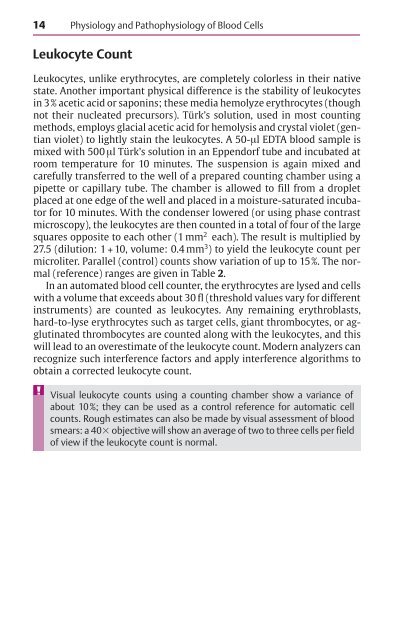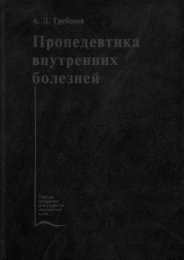Color Atlas of Hematology - Practical Microscopic and Clinical ...
Color Atlas of Hematology - Practical Microscopic and Clinical ...
Color Atlas of Hematology - Practical Microscopic and Clinical ...
- No tags were found...
You also want an ePaper? Increase the reach of your titles
YUMPU automatically turns print PDFs into web optimized ePapers that Google loves.
14Physiology <strong>and</strong> Pathophysiology <strong>of</strong> Blood CellsLeukocyte CountLeukocytes, unlike erythrocytes, are completely colorless in their nativestate. Another important physical difference is the stability <strong>of</strong> leukocytesin 3% acetic acid or saponins; these media hemolyze erythrocytes (thoughnot their nucleated precursors). Türk’s solution, used in most countingmethods, employs glacial acetic acid for hemolysis <strong>and</strong> crystal violet (gentianviolet) to lightly stain the leukocytes. A 50-µl EDTA blood sample ismixed with 500 µl Türk’s solution in an Eppendorf tube <strong>and</strong> incubated atroom temperature for 10 minutes. The suspension is again mixed <strong>and</strong>carefully transferred to the well <strong>of</strong> a prepared counting chamber using apipette or capillary tube. The chamber is allowed to fill from a dropletplaced at one edge <strong>of</strong> the well <strong>and</strong> placed in a moisture-saturated incubatorfor 10 minutes. With the condenser lowered (or using phase contrastmicroscopy), the leukocytes are then counted in a total <strong>of</strong> four <strong>of</strong> the largesquares opposite to each other (1 mm 2 each). The result is multiplied by27.5 (dilution: 1 + 10, volume: 0.4 mm 3 ) to yield the leukocyte count permicroliter. Parallel (control) counts show variation <strong>of</strong> up to 15%. The normal(reference) ranges are given in Table 2.In an automated blood cell counter, the erythrocytes are lysed <strong>and</strong> cellswith a volume that exceeds about 30 fl (threshold values vary for differentinstruments) are counted as leukocytes. Any remaining erythroblasts,hard-to-lyse erythrocytes such as target cells, giant thrombocytes, or agglutinatedthrombocytes are counted along with the leukocytes, <strong>and</strong> thiswill lead to an overestimate <strong>of</strong> the leukocyte count. Modern analyzers canrecognize such interference factors <strong>and</strong> apply interference algorithms toobtain a corrected leukocyte count.Visual leukocyte counts using a counting chamber show a variance <strong>of</strong>about 10%; they can be used as a control reference for automatic cellcounts. Rough estimates can also be made by visual assessment <strong>of</strong> bloodsmears: a 40 objective will show an average <strong>of</strong> two to three cells per field<strong>of</strong> view if the leukocyte count is normal.






